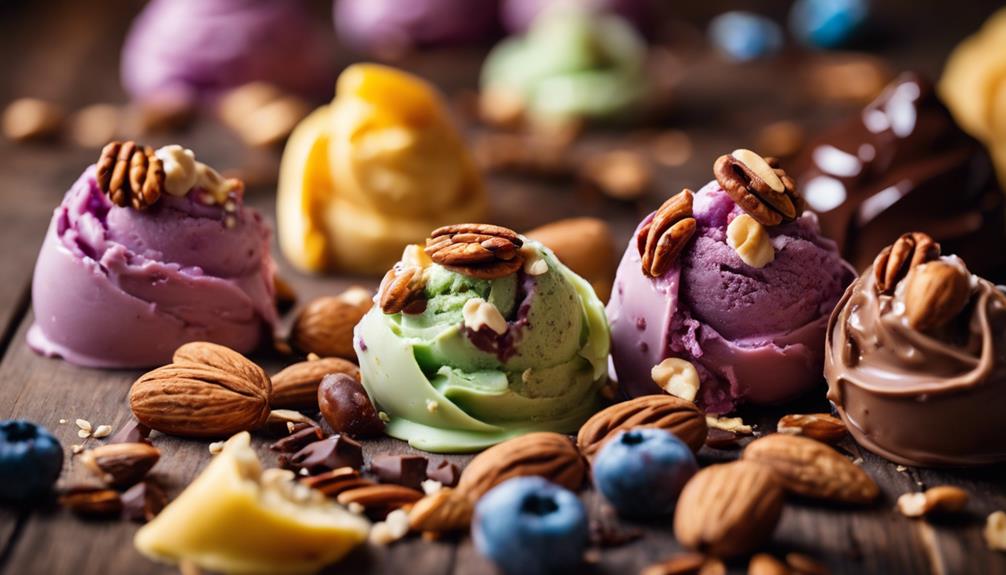Gelato is primarily made of whole milk, heavy cream, granulated sugar, and sometimes egg yolks, which help enhance its flavor and texture. With a lower fat content ranging from 4% to 9%, gelato allows the true flavors to stand out. You’ll discover ingredients like fruit purees, chocolate pastes, and natural flavorings that provide a rich taste experience. Stabilizers and emulsifiers are also incorporated to achieve that smooth, creamy texture without adding excess air. This unique combination of ingredients differentiates gelato from ice cream. Explore the exciting ways these elements blend together to create your favorite flavors! For those with dietary restrictions, there are also dairy-free gelato options available that use alternative milks such as almond, coconut, or oat milk as a base. These dairy-free versions still maintain the creamy texture and rich flavor of traditional gelato, making it suitable for a wider audience. Whether you enjoy classic flavors or wish to try innovative combinations, there’s a gelato option for everyone to savor.
Key Takeaways
- Gelato is primarily made from whole milk, heavy cream, granulated sugar, and egg yolks for richness and flavor.
- The typical milk-to-cream ratio in gelato is 70% milk to 30% cream, providing a creamy texture.
- Stabilizers like guar gum and emulsifiers such as lecithin are added to enhance texture and prevent ice crystals.
- Flavorings include high-quality vanilla, fruit purees, and chocolate pastes, which enrich the overall taste profile.
Overview of Gelato Ingredients
Gelato ingredients come together to create a rich and creamy treat that stands apart from traditional ice cream. When you immerse yourself in a gelato recipe, you'll notice the unique combination of whole milk, heavy cream, granulated sugar, and egg yolks. These elements work in harmony to deliver that signature smooth texture and intense flavor you crave.
The use of egg yolks in gelato not only thickens the mixture but also enriches the taste, making it feel indulgent. Unlike ice cream, which typically contains more heavy cream, gelato relies on a higher milk content. This lower fat level, usually between 4% to 9% butterfat, allows the flavors to shine through more vividly.
You'll also find various flavoring ingredients, such as vanilla beans, fruit purees, and chocolate pastes, which enhance the gelato experience while staying true to its Italian roots. Some recipes may include stabilizers and emulsifiers to improve texture and creaminess without adding too much air.
Whether you're enjoying classic flavors or innovative combinations, understanding these ingredients will deepen your appreciation for this beloved treat.
Dairy Components in Gelato

When you enjoy gelato, you're savoring the unique blend of milk and cream that creates its signature texture.
Whole milk serves as the foundation, while varying amounts of heavy cream add richness without overwhelming it.
Let's explore the types of milk used and how cream variations contribute to that deliciously dense experience.
Milk Types Used
Whole milk serves as the primary dairy component in gelato, giving it a creamy texture and rich flavor. In gelato, the milk-to-cream ratio is higher compared to ice cream, typically consisting of about 70% milk and only 30% cream. This balance plays an essential role in creating gelato's signature smoothness while allowing the flavors to shine through.
The fat content in gelato ranges from 4% to 9% butterfat, which is significantly lower than the 10% to 25% commonly found in ice cream. This reduced fat content enhances the flavor experience, as it doesn't coat your palate as heavily, allowing you to savor each taste.
Unlike traditional ice cream, authentic gelato often excludes egg yolks, relying solely on milk and cream to achieve that desired creamy richness. Some recipes may venture into alternative milk options like almond or oat milk, catering to those with dairy-free preferences while still aiming for that indulgent texture.
Ultimately, the choice of milk types in gelato is fundamental to its appeal, creating a delightful treat that stands apart from ice cream.
Cream Variations Explained
The cream variations in gelato play an essential role in achieving its signature texture and flavor profile, making it a delightful treat for everyone. Unlike traditional ice cream, Italian gelato utilizes more milk, resulting in a lower fat content that typically ranges from 4% to 9% butterfat. This focus on milk allows for a denser and creamier consistency without the fluffiness that eggs would introduce.
Here are three key aspects of cream variations in gelato:
- Milk vs. Cream: Authentic gelato recipes contain less heavy cream compared to ice cream, prioritizing milk to create that smooth texture.
- No Egg Yolks: Traditional gelato often excludes egg yolks, relying instead on milk and cream to achieve richness and creaminess.
- Alternative Dairy Options: For vegan gelato, creators can use almond or oat milk, ensuring a creamy mouthfeel while accommodating dietary needs.
Sweeteners and Flavorings

Sweeteners and flavorings play essential roles in crafting the perfect gelato, balancing sweetness and enhancing the overall taste experience. The primary sweetener used is granulated sugar, typically around 3/4 cup (150g) for every 2 cups (475 ml) of milk in your base recipe. This ratio guarantees a delightful sweetness that complements the rich flavors.
You might also consider alternative sweeteners like dextrose or glucose, which help achieve a softer texture and creaminess that gelato is famous for.
When it comes to flavorings, vanilla stands out as a classic choice. Using either a whole vanilla bean or pure vanilla extract can elevate your gelato's flavor profile considerably.
After the maturation phase, you can introduce various flavoring pastes, such as nut pastes or fruit purees, to add depth without overwhelming the base. You can also explore different flavor combinations, like cocoa powder for chocolate gelato or coffee grounds for that rich coffee experience.
Seasonal fruits like strawberries and peaches allow you to create diverse gelato experiences that keep your taste buds excited.
Additional Ingredients for Texture

When you think about what makes gelato so creamy, consider the roles of stabilizers and emulsifiers.
These ingredients not only enhance texture but also prevent ice crystals from forming, ensuring a smooth experience.
Adding milk proteins and vegetable fibers can further elevate the creaminess and overall mouthfeel, giving your gelato that irresistible quality.
Role of Stabilizers
Stabilizers play an essential role in gelato production by ensuring a smooth, creamy texture and preventing ice crystal formation. When you indulge in gelato, you want that rich, velvety mouthfeel. Stabilizers help achieve this by absorbing water and forming a gel-like structure, which enhances the overall texture.
Here are three common stabilizers you'll find in gelato:
- Guar Gum: Derived from guar beans, this stabilizer thickens and improves texture while maintaining creaminess.
- Xanthan Gum: Produced through fermentation, xanthan gum not only stabilizes but also helps to retain moisture, preventing ice crystals from forming.
- Locust Bean Gum: Extracted from carob seeds, this natural stabilizer enhances the gelato's texture and contributes to its smoothness.
The right balance of stabilizers is essential; too much can lead to a gummy texture, while too little results in an icy mouthfeel. By incorporating stabilizers, gelato makers can lower fat content without sacrificing the delightful creaminess lovers expect.
Emulsifiers and Creaminess
Emulsifiers, like lecithin, play an essential role in giving gelato that irresistibly smooth and creamy texture you crave. They stabilize the mixture by binding water and fat, ensuring a delightful mouthfeel. The right balance of milk proteins and vegetable fibers enhances the creaminess, making every spoonful rich and satisfying.
To further illustrate the importance of emulsifiers in gelato, consider the following table:
| Emulsifier | Effect on Texture |
|---|---|
| Lecithin | Binds water and fat for smoothness |
| Guar Gum | Prevents ice crystal formation |
| Xanthan Gum | Enhances viscosity and creaminess |
| Dextrose | Softens texture, reduces icy feel |
| Vegetable Fibers | Thickens and stabilizes the mixture |
Texture Enhancers Explained
To achieve that perfect gelato texture, you'll often find texture enhancers like stabilizers and emulsifiers working together behind the scenes. These ingredients are vital for maintaining a creamy consistency while preventing ice crystal formation during the freezing process.
Here are three key texture enhancers that play an important role in your beloved gelato:
- Stabilizers: Ingredients like guar gum and carboxymethyl cellulose increase viscosity and moisture retention, improving the overall texture. They help guarantee your gelato remains smooth and scoopable.
- Emulsifiers: Lecithin is a common emulsifier that blends fats and liquids seamlessly. This results in a smoother mouthfeel and prevents ingredient separation, enhancing your gelato experience.
- Vegetable Fibers: Ingredients like inulin not only enhance creaminess but also add fiber, catering to health-conscious consumers who want a guilt-free treat.
Additionally, the balance of sugar types, including dextrose and glucose, can influence texture. These alternatives lower the freezing point, creating a softer gelato.
Flavoring Techniques and Innovations

Exploring flavoring techniques and innovations in gelato reveals a world of creative possibilities that elevate this beloved treat beyond traditional boundaries.
One of the key methods involves using flavoring pastes, such as nut pastes and fruit purees, which enhance and intensify the flavor profiles while keeping the smooth texture you love. By incorporating high-quality ingredients, like seasonal fruits and premium chocolates, you guarantee that every scoop delivers intense flavors that resonate with each bite.
The traditional recipes, like tiramisu or stracciatella, showcase regional Italian flavors, but today, you can also indulge in unique combinations. Imagine savoring flavors like lavender and matcha, which cater to evolving consumer preferences for artisanal and gourmet experiences.
Vegan gelato options are also on the rise, using alternative ingredients like coconut milk or aquafaba, expanding the range of innovative flavors available. This versatility allows you to enjoy gelato that aligns with your dietary choices while still delighting your taste buds.
With these flavoring techniques and innovations, gelato continues to surprise and enchant, offering something for everyone.
Equipment Used for Gelato Making

When it comes to making gelato, having the right equipment can make all the difference in achieving that creamy, smooth texture you crave. Unlike traditional ice cream makers, gelato production requires specialized machinery that guarantees the perfect balance of temperature and mixing.
Here are three essential items that you'll need for crafting delicious frozen treats:
- Batch Freezer: This machine blends and freezes your gelato mixture in about ten minutes, creating that rich texture you love. It's essential for incorporating air while keeping the temperature low.
- Pasteurizing Machine: Hygiene is key in gelato production. This equipment eliminates harmful bacteria from your mixture, guaranteeing that your gelato is safe and delicious.
- Maturation Vat: After mixing, gelato needs to rest in a maturation vat to develop its flavors at ideal temperatures. This step is crucial for large-scale production and enhances the final taste of your gelato.
When you invest in high-quality gelato equipment, you're setting yourself up for success in creating irresistible frozen treats that will impress everyone!
Nutritional Aspects of Gelato

Understanding the nutritional aspects of gelato can help you appreciate its unique qualities compared to traditional ice cream. One of the standout features of gelato is its lower fat content, which ranges from 4% to 9%. In contrast, ice cream can contain anywhere from 10% to 25% fat. This difference not only lowers the calorie count—gelato typically has about 150-200 calories per serving versus 200-300 for ice cream—but also contributes to its denser texture and more intense flavor.
Gelato often uses whole milk and minimal cream, resulting in reduced saturated fat intake. While sugar levels can vary, gelato averages around 20-30 grams per serving. Some gelato makers even utilize specific ingredients, like alternative sweeteners, to create lighter options without sacrificing taste.
Additionally, gelato's lower air content and serving temperature enhance its flavor experience. This means you can enjoy a smaller serving size while still satisfying your cravings. So, when you choose gelato over ice cream, you're not just indulging; you're also opting for a treat that's lighter and potentially more flavorful.
Frequently Asked Questions
What Is Real Gelato Made Of?
Real gelato's made from whole milk, heavy cream, and sugar, giving it that creamy texture you love. You'll often find flavor enhancers like fruit purees or nut pastes, which intensify the delicious taste.
What Makes Gelato Different From Ice Cream?
Gelato differs from ice cream mainly in texture and ingredients. You'll notice it's denser and creamier, with less air and fat. It's also served warmer, enhancing the intense flavors you love.
Is Gelato Healthier Than Ice Cream?
Yes, gelato can be healthier than ice cream. With lower fat and fewer calories, it often features more natural ingredients. You'll enjoy a denser, more flavorful treat without the extra calories and artificial additives.
What Is the Secret of Italian Gelato?
Did you know authentic Italian gelato contains about 4% to 9% fat? The secret lies in its unique texture, achieved through slow churning, high-quality ingredients, and a resting phase for deep flavor development.
Conclusion
In the world of frozen treats, gelato stands out with its creamy richness, yet it's lighter than traditional ice cream.
While it boasts fewer calories, it's packed with intense flavors that dance on your palate.
The balance between dairy and sweeteners creates a delightful experience, unlike any other dessert.
So, the next time you indulge in a scoop, remember: gelato isn't just a treat; it's a moment of pure joy crafted from simple, high-quality ingredients.
















